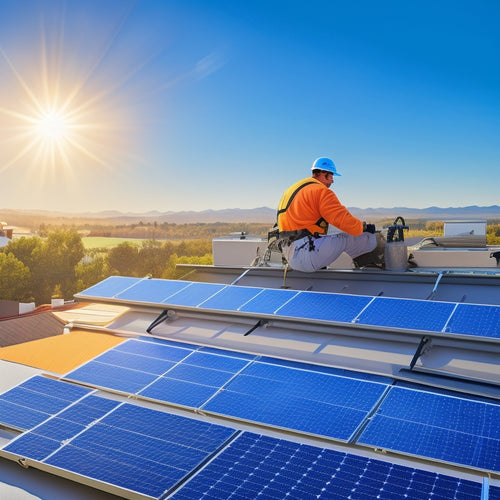
How to Install a Solar System at Your Residential House
Share
To install a solar system at your residential house, start by determining your daily energy consumption by reviewing past electricity bills and analyzing usage patterns. Next, choose the right equipment, including solar panels, inverters, and mounting systems, based on your energy needs and budget. Prepare your roof and site by evaluating its condition, considering site orientation, and clearing the area of debris. Then, install the solar panels on a racking system, ensuring compatibility with your roof type and panel brand. Finally, connect your system to the grid, involving the installation of a bi-directional meter, and get ready to utilize the power of the sun - but that's just the beginning of your solar expedition.
Key Takeaways
- Determine your daily energy consumption by reviewing past electricity bills to design a suitable solar system.
- Choose the right equipment, including solar panels, inverters, and batteries, based on your energy needs and budget.
- Prepare your roof and site by assessing roof condition, evaluating site orientation, and clearing the area for installation access.
- Install solar panels securely on a racking system, ensuring compatibility with your roof type and solar panel brand.
- Connect your solar system to the grid by installing a bi-directional meter and a grid tie inverter, and verifying compliance with utility company requirements.
Assessing Your Energy Needs
When sizing up a solar system for your home, understanding your energy needs is the critical first step. You need to determine how much energy you consume daily to accurately size your solar system. Review your past electricity bills to get an idea of your energy consumption patterns. Analyze your usage during peak hours, seasons, and days of the week. This data will help you identify areas where you can enhance energy consumption.
Consider your energy-intensive appliances, lighting, and HVAC systems, and calculate their individual energy loads. Factor in any potential future energy demands, such as adding an electric vehicle or upgrading to energy-hungry appliances.
By accounting for these variables, you'll get an accurate representation of your energy needs. This information will enable you to design a solar system that meets your energy demands, ensuring you maximize your solar incentives and achieve ideal energy independence.
With a clear understanding of your energy needs, you'll be well-equipped to select the right solar system components and configuration for your home.
Choosing the Right Equipment
Your solar system's performance hinges on the quality and compatibility of its components. When choosing the right equipment, you'll need to take into account solar panel types, inverter options, battery storage, mounting systems, and monitoring solutions.
For solar panels, you'll decide between monocrystalline, polycrystalline, and thin-film types, each with its efficiency, durability, and cost implications.
Inverters convert DC power to AC; you'll choose between string, micro, and power optimizers, depending on your system's size and complexity.
Battery storage options, such as lithium-ion or lead-acid, will impact your system's backup capabilities and installation costs.
Mounting systems, including roof-mounted, ground-mounted, and tracking systems, affect your system's energy output and durability.
Monitoring solutions provide real-time data on your system's performance; you'll select from options like cellular, Wi-Fi, or Ethernet connectivity.
Finally, take into account the installation costs, which vary depending on the equipment, labor, and local incentives.
Preparing Your Roof and Site
With your equipment selected, it's time to confirm your roof and site are ready for installation. Assess your roof's condition to ascertain it can support the weight of the solar panels. Check for damaged, missing, or loose shingles, and repair or replace them as needed. Verify that your roof's structure can handle the additional weight, and consult a professional if you're unsure.
Next, evaluate your site's orientation to maximize energy production. Ideal sites face south, with minimal shading from trees, buildings, or other obstructions. Take note of the surrounding environment, including potential shading sources, and plan accordingly.
Confirm the area around your roof is clear of debris and obstructions, allowing for easy access during installation. Measure your roof's dimensions and identify any obstacles, such as vents, skylights, or chimneys, that may affect panel placement.
Installing the Solar Panels
The solar panel installation process begins on the roof, where a racking system is secured to the roof's surface. This involves attaching brackets and clamps to the roof's rafters, guaranteeing a sturdy base for the solar panels.
You'll need to verify the racking system is compatible with your roof type and solar panel brand.
Next, you'll place the solar panels on the racking system, following the predetermined panel placement strategy to maximize energy production. This typically involves arranging panels in a horizontal orientation, with a slight tilt to allow snow to slide off.
Be sure to secure each panel to the racking system using the manufacturer's recommended fasteners.
Before proceeding, verify that you've obtained all necessary installation permits from your local authorities. These permits confirm your solar installation meets local building codes and regulations.
With permits in hand, you can complete the installation, connecting the solar panels to the inverter and monitoring system.
Connecting to the Grid
Frequently, homeowners overlook the importance of connecting their solar system to the grid, but this step is crucial for feeding excess energy back into the electrical grid and offsetting your utility bills.
You'll need to understand the grid connection process, which involves installing a bi-directional meter that measures the electricity you produce and consume. This meter allows you to take advantage of net metering benefits, where you can sell excess energy back to the utility company and receive credits on your bill.
When connecting to the grid, you'll need to verify your system meets the utility company's interconnection requirements. This typically involves installing a grid tie inverter, which converts DC power from your solar panels to AC power that's compatible with the grid.
You'll also need to install a disconnect switch, which allows utility workers to safely access the grid during maintenance or repairs.
Frequently Asked Questions
Can I Install Solar Panels on My Own Without Professional Help?
As you consider DIY installation, coincidentally, safety considerations arise; without proper training, you'll face challenges, overlooking required tools and local regulations, ultimately offsetting cost savings, and potentially putting yourself at risk.
How Long Does a Typical Solar Panel System Last?
You can expect a typical solar panel system to last around 25-30 years, with some lasting up to 40 years, depending on maintenance requirements, such as regular cleaning and inspections, which impact the solar panel lifespan.
Are There Any Solar Panel Warranties or Guarantees?
You'll find comfort in knowing that reputable manufacturers like Tesla offer extensive warranties, such as their 25-year performance warranty, covering defects and degradation, along with installation guarantees that protect your investment.
Can I Use Solar Panels to Power My Electric Vehicle?
You can definitely use solar panels to power your electric vehicle, leveraging charging infrastructure like Level 2 chargers, and taking advantage of solar incentives like the Solar Investment Tax Credit to maximize your savings.
Do Solar Panels Increase My Home's Value and Saleability?
Your solar investment is a gem in your property's crown, greatly enhancing its value and saleability, as a property appraisal will reveal, making your home shine brighter to potential buyers, like a guiding light in a sea of ordinary listings.
Related Posts
-

Why Higher Upfront Costs Are Worth It
You pay a premium for high-quality, energy-efficient products, but they're worth it. With durability testing ensuring...
-

Top 10 DIY Conversion Kit Reviews and Tips
You're taking the first step towards electrifying your ride, and with the right DIY conversion kit, you'll be cruisin...
-

3 Essential Steps for Solar Electricity Installation
To guarantee a successful solar electricity installation, you'll need to follow three essential steps. First, assess ...


